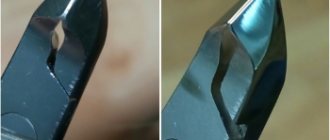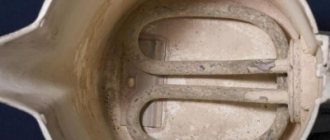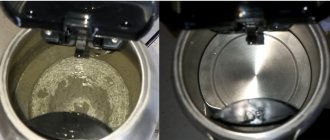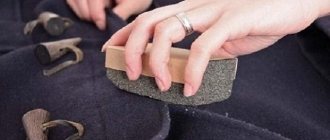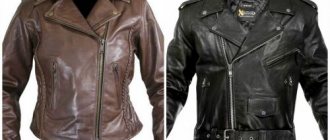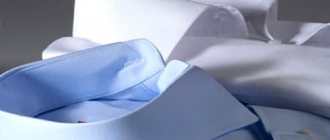How to prepare scissors for sharpening
Before you start sharpening, check whether the performance of the blades is actually affected by dullness. Sometimes scissors may not cut well due to the loosening of the connecting element. It could be a bolt or rivet.
After fixing all the problems, cut something and thereby check whether sharpening is needed. If the blades do not cut well, you will need to sharpen them. Before use, wipe the knives with a cotton swab and an alcohol solution. Remove more stubborn stains using suitable chemicals.
Self-sharpening hairdressing scissors: how to sharpen correctly?
I admit that the answer to this question will disappoint you.
But it’s better if he disappoints you - because the alternative is completely bad. Sharpening professional hairdressing scissors yourself is a simple matter. Go to any river, lake or pond, take the scissors in your right hand, swing them harder and throw them further into the water. Please - self-sharpening is completed.
You may ask what sharpening has to do with it.
It’s simple: sharpening hairdressing tools without the appropriate equipment and experience is the same as throwing them into the river. Most likely, you will no longer be able to use them. There is a chance that professionals from the service center will be able to resuscitate them - but it is small. There is a chance that fishermen will be able to fish your scissors out of the pond - and it is about the same.
But if you really try to sharpen the scissors, you will spend more time, nerves, and perhaps invest in some kind of sharpening materials. What is this all for? Save money - throw them away immediately without suffering.
Table of contents:
- Why can't you sharpen professional scissors yourself?
- How do you know when it's time to sharpen your scissors?
Reading time: 3 minutes.
Self-sharpening methods at home
There are many ways to sharpen scissor blades at home. To do this, you can use improvised materials that are found in almost every apartment.
Needle or awl
To sharpen you will need a thick needle or awl. The method is quite energy-intensive, so it is suitable for processing small scissors.
Cut the selected item from the rings to the tips of the blades. Try to guide the needle along the sharp edges. Your actions should not be performed through force.
Metal sponge
You can use either new or used metal sponge. The softer the sponge, the better.
Cut the sponge with scissors, using the entire surface of the blades. The more cuts you make, the sharper the blades will be. Please note that during the procedure the sponge crumbles a lot, so it is better to cut directly above the trash can.
Glass jar or bottle
In this procedure, it is best to use an unnecessary jar, since after sharpening there will be scratches on the glass.
- Take the jar in your hand and make the required number of cutting movements. During sharpening, the entire surface of the blades should touch the glass.
- After work, carefully remove small glass fragments from the surface of the blades.
- If you need to sharpen small scissors, use a glass bottle with a narrow neck.
Foil
Take a sheet of foil and fold it into 6-8 layers. You should get a fairly dense layer. Cut the foil into small strips, using the entire surface of the blades. The duller the knives, the more cuts you need to make.
Special sharpeners
A special sharpener can be purchased at a hardware or construction department or ordered from an online store.
Open the scissors and slide each blade through the designated hole. Do the required number of passes until the blades become sharp.
Sandpaper
Like other available materials, scissors are sharpened with sandpaper by cutting it. First, fold the paper in half with the rough side facing out and cut into small strips.
The finer the sandpaper grains, the better. The ideal option would be zero-grit sandpaper.
File
Open the scissors to their maximum width and hold with your hand where the blades meet. This will allow each half to hold tightly and not become loose during the procedure.
File the inside of each blade at a 70 to 80 degree angle. Make movements either only from yourself, or only towards yourself. Never saw the blades by jerking back and forth. Just a few movements are enough to sharpen.
If you cannot hold the scissors tightly with your hand, use a vice.
Grindstone
A similar stone can be purchased at a hardware store or hardware store. Before sharpening, separate the scissors into their component parts by unscrewing the central screw. Apply each blade in turn to the stone with its sharp side and make several movements towards or away from you until the desired sharpness is achieved. At the end of the procedure, assemble the halves by connecting them with a central screw.
Grinder
To use a sharpening machine, sufficient experience and dexterity is required.
The machine is a device with a rotating abrasive wheel. Simply turn on the device and place the halves on the sharpening disc.
In the procedure, it is extremely important to know what angle must be maintained between the blade and the wheel, as well as how long to sharpen, so if you are not familiar with the device, give preference to another method.
Paper clip
Please note that the larger the paperclip, the better.
Hold the paper clip tightly with the tips of the blades and slowly, squeezing the scissors with your fingers, draw it to the base. Repeat the procedure until the scissors are sharp enough. You'll know the scissors are sharpening when you notice small nicks in the paper clip.
Battery
In a similar way to a paper clip, you can sharpen scissors using an unnecessary AA battery. Please note that the battery must be in a metal casing. Clamp the battery with the blades and move it to the base the required number of times.
Screwdriver
Since the paperclip or battery is quite small, it can be replaced with a screwdriver to sharpen larger scissors. Place the screwdriver, metal side down, on a hard surface. Pinch it with the tips of the blades and slowly move it to the base. Repeat as many times as needed to keep the blades sharp.
Where can you sharpen scissors?
Typically, this service is provided in key-making or shoe repair shops. The cost of sharpening scissors is from 50 rubles, depending on the complexity of the service.
Sharpening methods
Before sharpening scissors, you need to understand the features of their use. The methods used for knives are not suitable in this case. This is due to the use of the edge cutting method, which requires sharpening angles of 300 or more.
Smaller edge angles are bad because the blade becomes dull faster and the cutting process is simplified. An important feature of the tool is the need to maintain the factory angle, since the design is adjusted to it.
You can sharpen the blades of the tool using the following methods:
- On a special machine. High quality processing, productivity.
- On the grindstone. The method is painstaking and difficult to implement due to the low accuracy of the sharpening angle.
- Sharpening stone. Simplicity and accessibility of the method. Turning is only possible on a perfectly flat surface, angle control is difficult, and grinding speed is low.
To quickly sharpen scissors, you can use the following tools and methods:
- foil;
- bottle;
- with a pin;
- by sharpening with a needle.
Sharpening scissors on a machine
Subtleties of the sharpening process
Depending on the type and purpose of the scissors, sharpening may have some subtleties and nuances.
Regular
Scissors that cut paper or other materials can be sharpened at home, spending very little time. Use foil, sandpaper, or another metal-coated object to sand the blades.
Kitchen
At home, it is best to sharpen kitchen scissors in a way that does not require disassembling them. Foil, sandpaper or metal sponge work well. However, such sharpening will not provide long-term results. For better processing, contact professionals.
Manicure
High-quality manicure scissors are quite difficult to sharpen at home. To do this, you need to know how to properly tighten the connecting element and what the sharpening angle should be. The blades are processed with a special diamond needle file from base to tip.
Hairdressers
Hair cutting scissors are made from high-quality materials, as they are designed for a long service life. Properly sharpening blades at home is very difficult and risky. Entrust sharpening to a professional who uses special laser equipment for the job.
Thinning
Thinning scissors have a special structure. They consist of double blades - serrated and straight. It is impossible to sharpen such an item at home, since the work requires certain equipment and knowledge.
Tailor's
It is extremely important when sharpening fabric scissors not to leave jagged edges on the blades, so use smoother materials for processing, such as foil or zero-grade sandpaper. After sharpening, be sure to check the quality of the cut on an unnecessary piece of fabric.
If these are zigzag scissors for processing the edges of fabric, then they can only be sharpened in a workshop.
Garden
For sharpening, you can use a whetstone or a machine. Disassemble the scissors into their component parts and sharpen them accordingly.
Metal scissors
To process metal scissors, be sure to maintain a sharpening angle of approximately 75 degrees. In preparation, separate the blades by unscrewing the connecting bolt. You can sharpen knives with a file or sandpaper. After the procedure, treat the parts with an anti-corrosion agent to extend their service life.
Sheep
Such scissors require maximum sharpness, so processing with foil or sandpaper will not work. Blades must be sharpened using a machine with an abrasive wheel. Process each blade separately, opening the halves as wide as possible.
Non-separable
Scissors cannot be disassembled without a connecting bolt. For sharpening, choose simple methods that do not require separating the halves, such as using a needle, foil or sandpaper.
How do scissors work and work?
The scissors have a symmetrical design, consisting of two moving parts, which are connected to each other by a bolt or rivet. Each part is a ring connected to a cutting edge. The parts of the structure fit tightly together.
Cutting is carried out due to the presence of a minimum gap between the two blades, which are driven like a lever mechanism. Fingers are threaded through the rings and the lever is activated.
Blade geometry
The blades have the following shapes:
- spicy;
- rounded;
- combined.
Cutting force
Cutting tools are produced for use in various fields. The difference lies not only in the size and geometry of the blades, but also in the amount of cutting force.
The force increases depending on the distance to the axis of rotation: the closer to the axis, the higher.
What not to do when sharpening scissors
To avoid ruining the sharpness of the blades:
- Do not try to sharpen non-standard scissors (hairdressing scissors, thinning scissors, manicure scissors) yourself. Their sharpening requires the use of professional equipment.
- Maintain the sharpening angle corresponding to the factory one. If handled incorrectly, the blades will become unusable.
- Do not disassemble the scissors if you are not sure that you can put them back together.
What else do you need to know about sharpening and caring for scissors?
Some useful tips
If the scissors become dull, then in order not to completely ruin the instrument, you should know and follow some nuances:
- You should not try to sharpen professional scissors on your own, as they require a special approach and knowledge when carrying out this process. Therefore, it is necessary to find a qualified craftsman who has special tools for this job. This type of scissors, as already noted, includes manicure, thinning, hairdressing and tailor's zigzag scissors.
- If you sharpen other types of scissors yourself, you should always observe the angle of the cutting edge specified during the manufacture of the tool.
- You should not disassemble the scissors if you are not sure that they can be assembled correctly, so that the blades fit tightly to each other.
Sharpening pruners with a file
- If work is carried out at home using a file or an abrasive stone, you cannot move it perpendicular to the blade, or back and forth. Movements should be directed only in one direction - from the connection of the blades to their end.
Possible reasons for poor scissor performance
In addition to the fact that scissors may become dull, there are several other reasons why a tool may begin to cut poorly. These include the following points:
- Sometimes it happens that the scissors are well sharpened, but still cut ugly. In this case, their blades should be brought together and turned to see if there is a gap between them. This is a common reason why a tool does not function as expected. And such a gap can arise due to high loads that are transferred to the tool during its operation. Because of this, the fastening weakens or even deforms the metal. In order to return the scissors to working condition, it is necessary to tighten the mounting bolt or align one or both blades. The bolt should not be tightened too much, otherwise the scissors will not work at all.
The gap between the blades will become a significant obstacle to high-quality cutting of fabric or paper.
If a rivet that has become loose is used as a fastening element for the two halves of the scissors, the scissors must be opened and placed on a solid surface, and then carefully hit the head of the rivet with a hammer so that it tightens again blades.
- Scissors can also be difficult to cut due to damage to the cutting edge. This can happen when trying to cut materials that are too hard for which the tool is not designed, or due to wear on the blades. If the reason for poor performance lies in a flaw in the sharp edge, then you should seek help from a workshop, where a master will sharpen and polish the cutting edge.
Rusty tailor's scissors can ruin expensive fabric.
- Rust on the inner surfaces of the blades can also cause the scissors to cut poorly or even not work at all. In this case, the plaque must be removed, otherwise it will leave a mark on all cut objects. The cleaning process can be carried out using improvised or special means. The latter perfectly eliminate plaque and will not damage the metal, but they are not cheap at all and are unlikely to be found in every home. The available tools that are available in every apartment include:
- baking soda mixed with water to a paste consistency;
- raw potatoes, cut in half;
- a solution of vinegar or citric acid.
One of these products is applied to a cotton swab, which is used to wipe the blades. If the plaque has already penetrated into the structure of the metal surface, you can first rub the surface with a metal kitchen sponge or “zero” sandpaper. This process should be carried out carefully so as not to damage the cutting part of the blade. After removing the bulk of the rust, the metal should be wiped with one of the above-mentioned products.
How to keep scissors in working condition for as long as possible
Scissors will function for a long time without repair if you follow the recommendations for their storage and operation. It is especially important to follow the following rules:
- If this is a specialized instrument—hairdressing or manicure scissors—that requires periodic disinfection, then it should be carried out exclusively with a special antiseptic.
And under no circumstances should you use boiling for disinfection! High temperatures will certainly cause unnecessary deformation of the metal. Plus, this is also an extra step towards the appearance of corrosion.
- Periodically, once every six months, it is recommended to lubricate the fastening mechanism with machine oil.
- Scissors should be used only for their intended purpose, and after use, wipe with a dry, clean cloth.
The case will protect the instrument from accidental damage and from moisture.
- The instrument must be stored in a case, and never left in a wet state, be sure to wipe them with a well-absorbing cloth.
* * * * * * *
So, in conclusion, it must be said that scissors are a simple tool that will work flawlessly if handled carefully and stored properly. As mentioned above, there is nothing difficult in sharpening scissors yourself if they are used for household needs. The workshop will help you sharpen and straighten a professional instrument.
Why don't scissors cut?
It happens that the blades retain their former sharpness, but the scissors still do not cut. In such cases, you need to check for a gap between the knives and also see if the cutting edge is broken.
How does a gap occur?
Due to increased loads, over time, the connection of the halves weakens slightly and a gap appears between the blades. Sometimes it happens that the metal of the knives becomes slightly deformed. To ensure that the scissors cut well again, adjust the mount or align the blades.
Cutting edge irregularities
Over time, the metal of the blades wears out and becomes deformed. To level the cutting edge, you should contact a professional craftsman who will sharpen and polish the surface of the edge.
How to adjust blade stroke
To adjust the fastener that affects the gap:
- If it is a bolt, carefully tighten it using a small screwdriver. Be careful not to over-tighten; if you tighten too much, the halves won't be able to move.
- If the connection is a rivet, open the scissors and place it on a metal surface. Then use a few blows of a hammer to flatten the plug.
- If there is a stop at the junction of the halves, open the scissors and carefully sharpen it.
Sharpening methods
A professional approach angle is formed on special machines in the factory. It must be preserved and maintained. The article does not discuss factory technology, but publishes simplified methods available to the home craftsman for bringing household models into working condition.
Scissor straightening tools
Sharpener
The blades of the scissors are spread apart and alternately pulled through the slot prepared in the tool. The supply metal is ground down with abrasive materials. Rotating disks can be used for this. All nicks and irregularities are removed to a single level.
Various types of sharpeners can be purchased through Chinese online stores.
Diamond needle file or file
When sharpening, scissors should be firmly fixed or held tightly in your hand, resting it on some stationary object, for example, a table surface.
The cutting surface of the file must be positioned in only one plane. This technique ensures the same sharpening angle along the entire length of the blade. Its factory value must not be violated.
If there is a large notch on the surface of the file, additional polishing of the lead with another tool may be required.
whetstone, whetstone, whetstone
It is advisable to disassemble the scissors, but you can also work in assembled form. The technology is the same as when sharpening a knife using these devices. The supply is placed on the surface of the sharpening stone, the blade is directed in one direction, and the same angle of inclination is maintained at all times. The abrasive material is periodically moistened with water, removing particles of cut metal.
The photo shows work on a homemade whetstone made from ceramic tiles with your own hands.
If the shape of the blade differs from a straight line, having a convexity or concavity, then the direction of sharpening movement is changed by 90 degrees.
Available means
Let's look at the most affordable sharpening tool:
- sandpaper;
- foil;
- steel wool;
- glass bottle neck;
- steel wire.
Sandpaper
Select varieties with the smallest grains - zero. Cut it along the entire length of the blade. The abrasive material of the sandpaper, passing under the cutting edges, sharpens them.
Food or technical thin foil
The material is folded in several layers, cuts are made along the entire length of the blade.
Foil kitchen sponge
This method works according to the technology of the previous one. Scissors should work along the entire length of the blade.
Glass bottle
Grasping the neck with both blades, make cutting movements along their entire length in both directions. Surfaces are polished. Therefore, the plane of the inlets is positioned in the optimal direction for their alignment.
Needle, screwdriver or steel wire
By squeezing and unclenching the scissors, they are simultaneously processed with force along the entire length of the blades with the inserted needle.
How to keep scissors sharp at home
To keep your blades sharp for as long as possible, follow these simple rules for using them:
- Do not use boiling to disinfect. It is better to wipe the blades with an antiseptic.
- Treat the mechanism for connecting the halves with any oil once every 6 months.
- Use scissors only to cut materials that are suitable for their intended purpose.
Always wipe the blades with a piece of cloth after use. Store scissors in a special case and do not allow liquids to come into contact with the knives.
How to sharpen homemade scissors using the standard method
In order to sharpen dull scissors at home, you can use both a traditional abrasive tool and proven folk methods, although some of them seem unusual.
It should be understood that when using grinding bars and wheels for home sharpening, the entire cutting surface is processed, and in other cases, only a slight correction of its pointed edge is performed.
Using a sharpening machine
It is very convenient to sharpen home cutting tools on a special sharpening machine, which is equipped with a device for clamping the product at a given angle and its fixed movement along the grinding wheel. However, this type of equipment, as a rule, is available only in special workshops or among craftsmen who make knives at home.
In principle, in order to sharpen cutting edges to the required sharpness, an ordinary electric sharpener, which is in the arsenal of almost every home workshop, is also suitable. For high-quality home sharpening, a support table is required, since the blades will have to be fixed manually, both in angle and length.
If you have no experience working on such a home machine, then before sharpening the scissors it is better to practice on an unnecessary piece of metal, since it is very easy to ruin them due to inexperience on a home electric sharpener.
Application of diamond wheel
If professional instruments are not available, the processing can be carried out using a diamond wheel. This method is more suitable for processing small or fragile items. Its features include the following points:
- You should work with a diamond wheel carefully, as mistakes made can cause a change in the sharpening angle. If you change the sharpening angle, the scissors will become unusable.
- It is recommended to set the device used to minimum speed. Sharpening should be done smoothly starting from the tip. Do not press too hard on the workpiece.
- It is not always possible to sharpen the blade in one go. Processing is carried out until the required result is achieved.
Instead of a diamond wheel, you can use a diamond nefil. To sharpen nail scissors, you should use two types of diamond nefil: first, processing is carried out with a coarser grain, then with a fine-grained tool. By using abrasives with different grain sizes, you can achieve better results.
Use of whetstone
In the household, the most popular sharpening tool is the whetstone. Usually this is a flat rectangular block of fine abrasive, which can be purchased at any tool store. This type of home sharpening requires steady hand and some skill, but if all recommendations are followed, it gives one of the best results.
Before starting work, place the block on a piece of cloth and moisten its surface with water. If the household scissors are non-separable, then it must be placed on the edge of the table. If they can be separated, disassemble the scissors into two halves by unscrewing the fastening screw.
Then, holding one of the parts by the ring and handle, fix it at the angle of inclination of the cutting edge and move it with pressure along the surface of the block several dozen times. The movement should be performed away from you and only in one direction.
As you work, regularly inspect the blade and, as soon as it looks smooth and sharp, move on to the other half. After finishing home sharpening on a block, wipe both halves with a napkin and then connect them with a screw.
Using a vice and file
Flat files are used to sharpen the edges of medium and large-sized household scissors. In this case, a prerequisite is their fixation in a bench vice. For sharpening, ordinary files No. 3–4 or with diamond coating are most often used.
Any vice is suitable for this type of work - like those found in any garage or home workshop. When clamping household scissors, they should be carefully aligned vertically, and it is desirable that the end of the blade is completely clamped by the jaws of the vice.
They work with a file on their own, moving it strictly in accordance with the angle of the cutting edge. After processing, it is necessary to remove burrs from home scissors using sanding paper.
How to remove rust from scissors
If the metal is covered with rust, it can be removed using special or improvised means. Special substances easily cope with plaque and do not spoil the metal. However, such funds are not always available at hand, and they are quite expensive.
An alternative to store bought substances can be substances that are available in almost every apartment. You can remove rust with:
- slurry of water and soda;
- solution of citric acid or vinegar;
- peeled potatoes.
If the rust has not yet become deeply ingrained into the metal, the blades can be cleaned with sandpaper or a metal sponge.
Scissors are a simple item that requires simple operating rules. Some types of them require special sharpening only in professional workshops. To process regular blades, you can use materials that are always on hand. At the same time, the procedure does not require any special skills from you, and also will not take much effort and time.
Tool
To sharpen scissors, use the following tool:
- sandpaper;
- file;
- machine with diamond wheel;
- whetstone;
- special sharpener;
- homemade gear device.
At home, you may not have special tools, so you can sharpen manicure or sewing scissors using improvised materials:
- a sheet of foil;
- needle, bottle or pin.
Types of scissors and methods of sharpening them
Since scissors are used a lot, you need to know how to work with certain devices. The smallest and largest products require their own approach - manicure and garden tools.
Nail scissors and clippers
Small instruments whose blades have a curved shape are especially treacherous. Even a slight inaccuracy in fixing parts can cause parts to diverge. Therefore, before returning the sharpness to them, their fastening must be corrected - the backlash is eliminated.
To adjust products with a screw, you will need a screwdriver. If parts of the scissors are held in place by a rivet, a center punch will be needed. For sharpening nail scissors, only one tool is suitable - a thin needle file with diamond coating and a very fine notch. A small vice is needed to secure them.
To be able to examine the result of the work, you can use a special magnifying glass - with a mount and backlight (or without it). You need to be very careful when working with a miniature tool. The reason is a demanding, fragile edge that is easily damaged.
Gardening Tools
These scissors, on the other hand, require larger tools. They use a vice, a large file and sandpaper. In this case, there are two options - sharpening the whole or “dismembered” device. It is still more convenient to process the halves. Therefore, the first step is to unscrew the nut and remove the screw.
The edges are brought out, starting the movement from the handle. All attention is paid to the correct position of the file. As a rule, scissors are sharpened away from themselves. Then the burrs are removed from the blades by grinding the surfaces with sandpaper. The best, most convenient option is processing using a sheet lying on the desktop.
Sharpening scissors using an emery stone
As mentioned above, the stone should be fine-grained. The second condition is that you need to sharpen the entire plane of the edge at the same time. The blade of the scissors should lie as shown in the photo. The entire plane and at the same time at an angle specified when the blade was stamped at the factory. Movement of the blade along the stone - along the blade, from the screw to the tip of the scissors. Well, the third condition is that you must have a “steady” hand. The angle of the blade cannot be changed when sharpening. Now be patient and sharpen, periodically removing any burrs that form on the inside of the blade by lightly moving the inside of the blade along the stone. Depending on the force applied to the blade and the quality of the emery wheel, in half an hour or an hour you will achieve that the scissors will cut perfectly. Attention! Be careful to protect your hands with leather gloves and do not allow children to sharpen scissors.
Needle
How to sharpen scissors with a needle? The method is very similar to glass manipulation:
- Take a large thick needle or sewing pin.
- Place the needle between the blades of the open scissors.
- Make several movements that simulate the cutting process.
How to sharpen nail scissors? Manicure scissors have rounded cutting edges, which makes sharpening more difficult. The small size of the tool leaves minimal options for sharpening the blades. The most acceptable way is to cut a sewing needle or the neck of a glass bottle.
Nail scissors: Pixabay
Glass
Small scissors are inconvenient to sharpen with a stone. To sharpen them, glass is often used, more precisely glass containers (jars, bottles). How to sharpen scissors with glass? Instructions for step-by-step sharpening:
- Take a glass container and place it on the table.
- Hold the jar with one hand and take the scissors with the other.
- Open the scissors and, placing the neck of the dish between the blades, make cutting movements.
- Repeat the cutting action until the edges of the scissors become smooth and have the desired sharpness.
To perform the manipulation, use a container that you do not mind: during the sharpening process, scratches may form on it.
Why can't you sharpen professional scissors yourself?
The best blades for scissors are the ones that you can apply the best edge to and not suffer from how quickly it wears off. Even the most beautiful blades with poor sharpening will be just rubbish.
But that's not so bad.
The trouble is that the structure of the metal can be damaged due to poor-quality sharpening - and even the most intelligent sharpener will not be able to make the cutting edge ideal.
And sharpening of some types of blades cannot be done efficiently even in most service centers. This primarily applies to convection blades and thinning blades. Both are sharpened on very high level equipment. However, in some ways it is easier with them - both are usually applied to high-hardness steel and do not require additional sharpening for years.
Operation according to rules
To ensure that the scissors serve for a long time and do not have to be sharpened often, follow the recommendations that we will give you.
Seamstresses often use a variety of fabrics for cutting:
- chiffon;
- linen;
- cotton;
- batiste;
- velveteen;
- cloth.
They all have different textures and densities. It is important that the scissors cut equally accurately on any material. Therefore, you need to keep the edges sharp and smooth.
1. After use, clean lint from the blades; use a cover for storage.
2. At least once every two weeks, during periods of active use, drip machine oil into the screw area and make sure that it does not unscrew.
3. We do not recommend cutting wet material, otherwise the steel will become covered with rust and your tool will become unusable.
The most important rule is that you can only cut fabric with tailor's scissors. This should be done on a flat surface, laying the cut out on a table or, in extreme cases, on the floor. Keep the fixture perpendicular to the plane of the base. Remember, only proper use keeps the edges sharp and not jagged, allowing them to be used for a long time.



